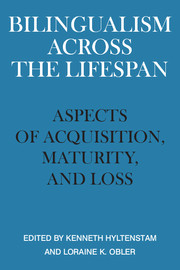Book contents
- Frontmatter
- Contents
- List of contributors
- Preface
- 1 Bilingualism across the lifespan: an introduction
- 2 Early differentiation of languages in bilingual children
- 3 Variation in children's ability to learn second languages
- 4 Idiomaticity as an indicator of second language proficiency
- 5 Prefabs, patterns and rules in interaction? Formulaic speech in adult learners' L2 Swedish
- 6 The imperfect conditional
- 7 Spanish, Japanese and Chinese speakers' acquisition of English relative clauses: new evidence for the headdirection parameter
- 8 Distinguishing language contact phenomena: evidence from Finnish–English bilingualism
- 9 The boustrophedal brain: laterality and dyslexia in bi-directional readers
- 10 Deterioration and creativity in childhood bilingualism
- 11 Crosslinguistic influence in language loss
- 12 Bilingualism in Alzheimer's dementia: two case studies
- 13 Language processing in the bilingual: evidence from language mixing
- Index
13 - Language processing in the bilingual: evidence from language mixing
Published online by Cambridge University Press: 05 June 2012
- Frontmatter
- Contents
- List of contributors
- Preface
- 1 Bilingualism across the lifespan: an introduction
- 2 Early differentiation of languages in bilingual children
- 3 Variation in children's ability to learn second languages
- 4 Idiomaticity as an indicator of second language proficiency
- 5 Prefabs, patterns and rules in interaction? Formulaic speech in adult learners' L2 Swedish
- 6 The imperfect conditional
- 7 Spanish, Japanese and Chinese speakers' acquisition of English relative clauses: new evidence for the headdirection parameter
- 8 Distinguishing language contact phenomena: evidence from Finnish–English bilingualism
- 9 The boustrophedal brain: laterality and dyslexia in bi-directional readers
- 10 Deterioration and creativity in childhood bilingualism
- 11 Crosslinguistic influence in language loss
- 12 Bilingualism in Alzheimer's dementia: two case studies
- 13 Language processing in the bilingual: evidence from language mixing
- Index
Summary
Introduction
One of the more important questions in the study of bilingualism is: to what extent are the bilinguals' two languages functionally independent and to what extent do they constitute a single functional system?
Evidence of interaction between systems, namely from language mixing or code mixing, provides an important source of data on bilingual language processing. While such data can come from normal bilinguals as well as bilingual aphasics, language mixing in bilingual aphasia is presumed to offer a direct window on the mechanism of interaction between language systems and is therefore more valuable in modeling the neurolinguistic organization of two language systems with respect to one another.
In this chapter I will outline a neurolinguistic model of language processing in the bilingual and then propose to account for language mixing in terms of the framework of this model. According to this framework, both languages are activated when a bilingual prepares to speak and the two language systems interact via links between corresponding stages along a processing continuum. The different manifestations of language mixing reflect the interaction of language systems at different levels of language processing.
I will begin by reviewing the examples of language mixing in aphasia that have been reported in the literature. I will then discuss the relationship between language mixing in aphasia and language mixing in normals. In the final part of the chapter I will outline the model and show how various forms of language mixing may arise in terms of this model.
- Type
- Chapter
- Information
- Bilingualism across the LifespanAspects of Acquisition, Maturity and Loss, pp. 227 - 244Publisher: Cambridge University PressPrint publication year: 1989
- 10
- Cited by

